Family : Irenidae

Text © Dr. Andrea Giordano

English translation by Mario Beltramini
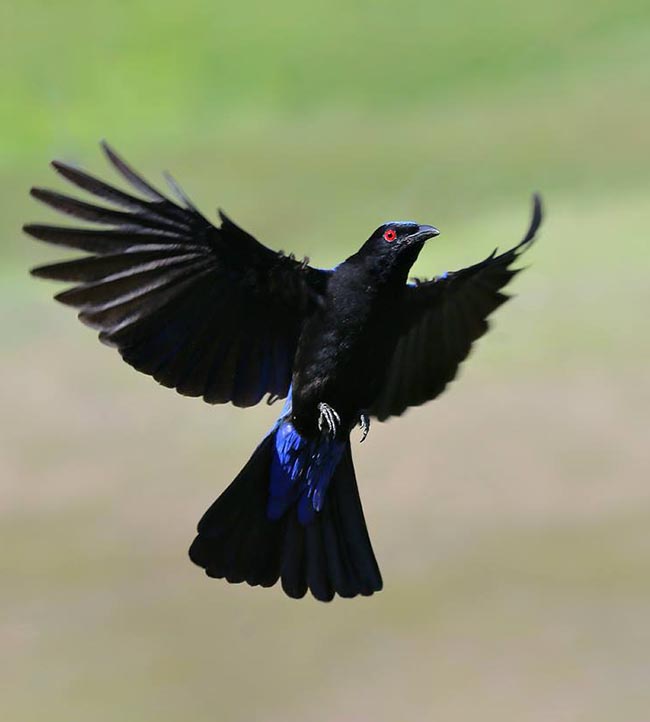
Legendary animal, Irena puella is a tropical passeriform of South-East Asia © Duy My
The Asian fairy-bluebird or Asian blue-backed fairy bluebird (Irena puella (J. Latham, 1790)), is a passeriform belonging to the family of the Irenids (Irenidae), protagonist of the human imagination since the dawn of time.
Irena, which is also the name of the genus it belongs, comes from the old Greek Eirḗnē (Eἰρήνη) and identifies the goddess of peace in the Hellenic mythology.
Moreover, Eirḗnē is one of the “Horae”, the keepers of Olympus and daughters of Zeus and Themis, always associated with the precious fruits that only peace can bring, that is, abundance and richness. Usually, it is represented as a young woman and this could explain the origin of the scientific name of the species puella.
In Latin, “puella” may have several meanings, more commonly that of “damsel”, often in a romantic or affective key. Its meaning can be ascribed to that of “daughter” or “maid”, but regardless to its exact translation, it appears clear the purpose of John Latham was that of strengthening the bond between this animal and the goddess. The fact that the Asian fairy-bluebird is a daughter, a maid or itself the embodiment of peace ( the “damsel ” Eirḗnē”), faithful disciple of non-violence remains.
Actually, this animal, together with the other membre of the genus, the Philippine Fairy-bluebird (Irena cynogastra), has always been associated, where the Irenas are known as “Fairy-bluebirds”, “Fairy azure or light blue”, although the Irenas present more iridescent, brilliant and changing plumages, or maybe we should have to better say “fairy”, they have been associated to the light blue (“bluebirds”), passeriformes of the genus Sialia present in the American continent only, due to the similar azure shades.
Divinity of peace and abundance, likeness of a “fairy”….. The Irenas really look like birds gone out from a tale, too beautiful to belong to this world.
Among the Tagalog population, one of the main ethnic groups in the Philippines, the Irena were often associated to the character of the tigmamanukan: the tigmamanukan were creatures having magical powers sent on the Earth by the god Bathala, creator of the universe in accordance with the Tagalog, or Tagalism, religion. The tigmamanukan could be reptiles, birds or small mammals, but it is mainly in the Irenas that the natived located the incarnation of these mystical creatures.
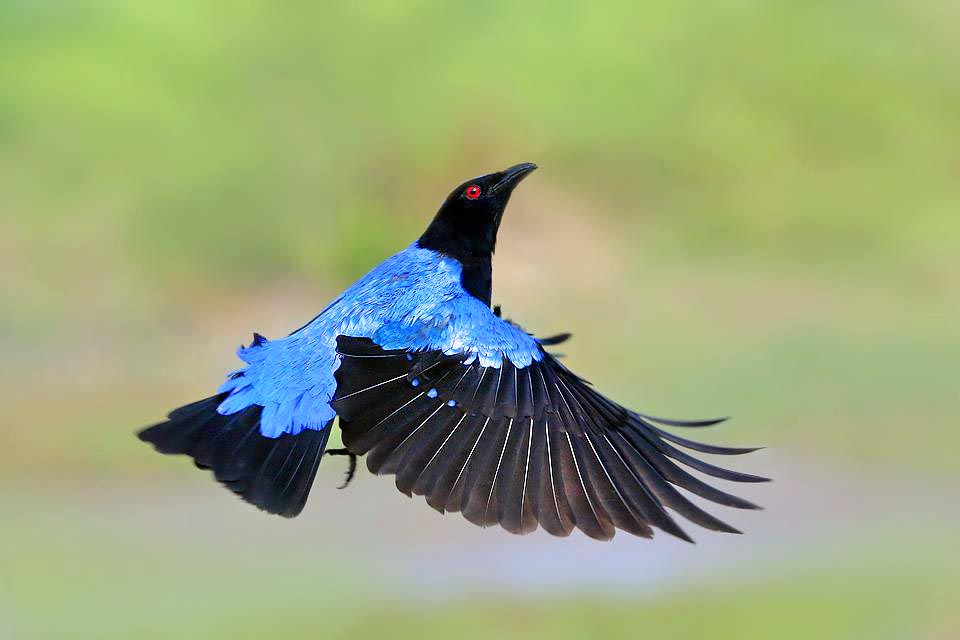
The males livery is spectacular, with that changing azure, depending on light, for the particular feathers barbs. Appears and vanishes quickly in the wings black © Duy My
It is not clear if the association concerned both Irenas, even if most of the scholars see in the more common Philippines Irena the chosen species: In the Philippine archipelago the blue-backed Irena populates only the island of Palawan and some lesser islands with the subspecies I. p. tweeddalei, after some scholars to be raise even to a species by itself, but nothing guarantees that the distributions of the two species can have been different in the past. After all…. The only element known to us is the fact that commonly the Tagalog people saw in the “bluebirds” the tigmamanukan.
As faithful messengers of the supreme Bathala, the Irenas played a crucial rôle of mediation between the voyagers and the divinity. The human beings in fact had to catch the messages that Bathala intended to transmit them by observing the flight of the Irenas: through the flight of an Irena from right to left, the divinity encouraged the travellers to continue their journey, whilst a flight from left to right warned against the certain failure that would prevent them from returning. Conversely, after other Tagalog beliefs, the Irenas did even contribute to the birth of the human species: it was rightly a tigmamanukan, whose garments thus assume even a mythological nature, that as per Bathala’s order opened with its own bill the primordial bamboos from which originated the first man and the first woman.
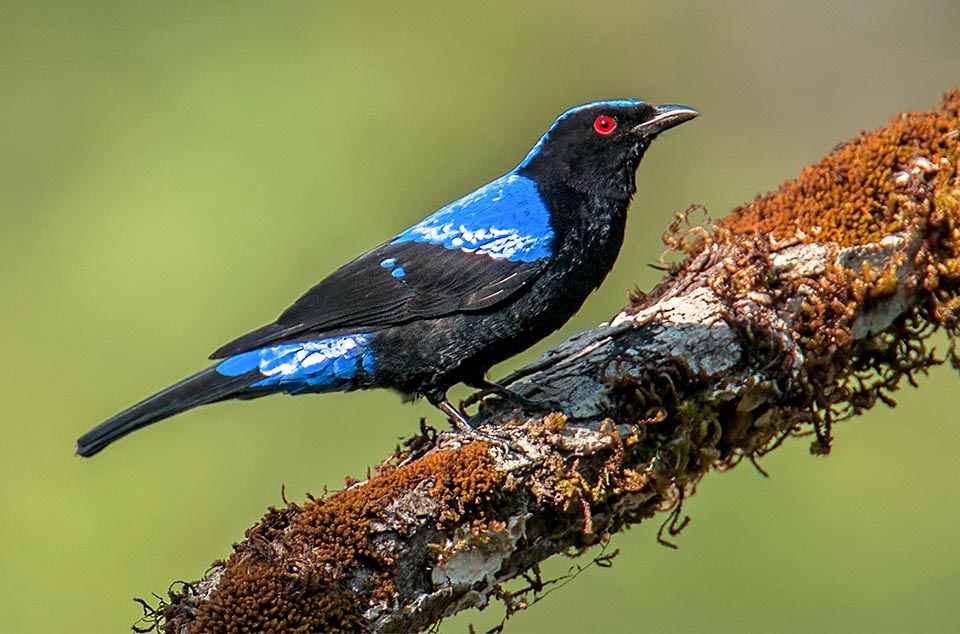
Same colour as the sky, rare in the birds, present on head, back and coverts. At times intense blue, at times azure, at times bright like the red eye © Bishan Monnappa
The same, like the Irenas, will take care to do a flight from right to left in order to encourage the couple in moving the first steps in the world.
Some local legends narrate that the bird protagonist of the legend was named “Manaul”, others describe it as the incarnation of “Amihan”, divinity of the wind and the peace, whilst other ones still believe that Manaul and Amihan were the same entity.
It’s fascinating to discover when the irenas have seized the imaginary of scholars and of believers.
It comes natural to ask ourselves what has aroused such consideration by man towards these animals embodying numerous symbolisms and protagonists of stories that exceed the boundaries between reality and legend. Ancient and irrational associations stanbd probably at the base of the difficult availability of exhaustive historical sources. As aforementioned, the blue-backed Irena, together with the Philippines Irena, has been linked for several contexts to the peace, the magid, the divinities and to their “heavenly order”.
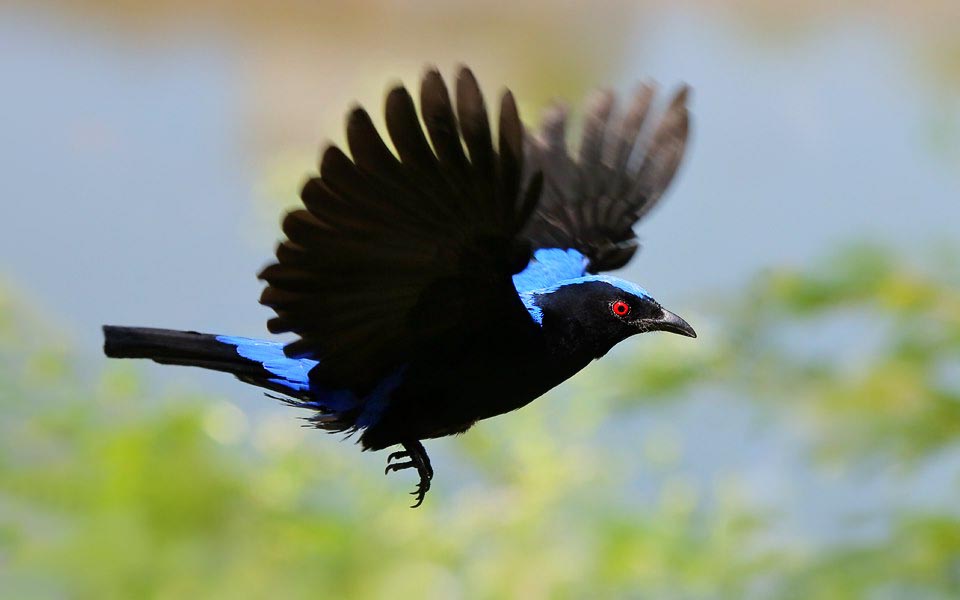
Livery that has stimulated human imaginary from the time dawn. Goddess of peace, as says the scientific name, magic bird on which many legends originated © Duy My
We know that since the most ancient times man has always been fascinated by the azure/bluish colouration of the Irenas, as the same was usually rare in many animal species. The colours affect our moods and our choices; disciplines such as the psychology of the colours could therefore be able to give us the answers we are looking for; the blue and the azure are colours that our unconscious associates to the immensity of the sky and of the seas, hence to scenarios able of making us feel a deep sense of liberty and of lightheartedness. They are colours that thanks to these properties are associated with calm, stability and purity and therefore ….. Also, peace, like the blue-backed Irena.
Moreover, we know that in many religions the divinities are often associated with the sky, and also this is not accidental. It is rightly from the calm and the stability of the mind that rationality gets origin…. The same that has “led” to the creation of our reality and to the natural order of the things. In this regard, also magic is often interconnected with these elements, and in the case of the species possibly even more.
The blue-backed Irena owes its name to the characteristic plulage of the male; the light blue robes with which it is endowed vary their brilliance according to the light intensity to which they are exposed, due to the complex structure of the barbs forming its feathers.
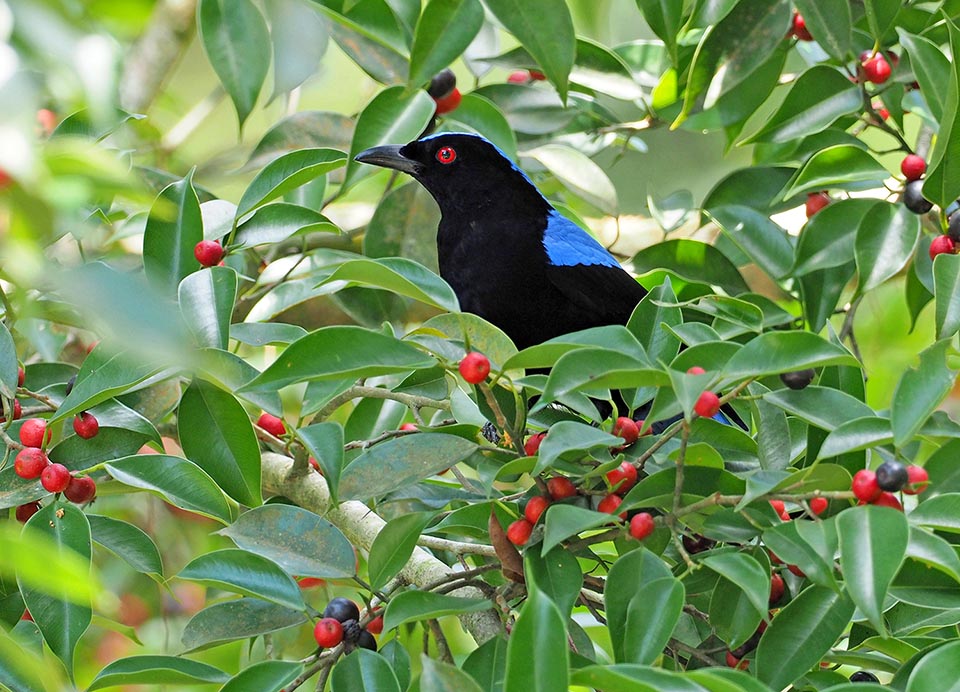
The long and strong bill has the typical form of the frugivores, and in fact we find it often looking for fruits among the leaves of many species of Ficus © Bitty Chong
The luminosity not only brings this blue plumage to develop more or less intense shades, but at times its brightness becomes so much intense to favour particular optical effects, giving the impression that the plumage is fluorescent or phosphorescent.
Conversely, if the light intensity decreases the portion of azure plumage may darken and become noticeably opaque , favouring its disguising into the vegetation. All this could have favoured a “magic” perception of the blue-backed Irena, the same that must have brought the scholars to compare the Irenas to fairies. We must say that in the Philippines Irena this phenomenon is less evident, as the male has smaller and localized zones of plumage endowed with a similar structure in the barbs.
Zoogeography
Much more diffused than the Philippines Irena, endemic to the archipelago, the blue-backed Irena enjoys a wide distribution, especially in South-East Asia where it can be sighted along all Indochina countries and several islands, among which, Sumatra, Java, Borneo and Palawan. It is also present along the Indian subcontinent and southern China.
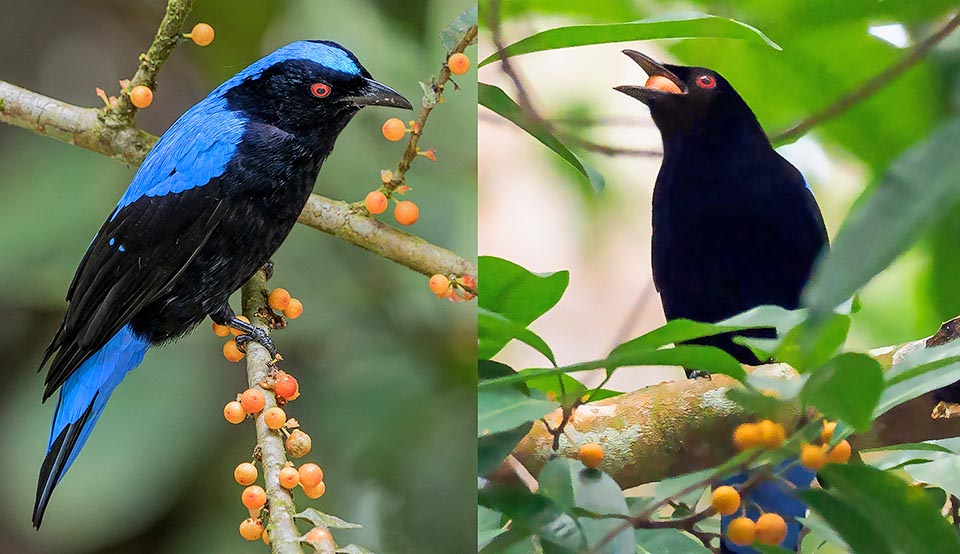
All sort of fruits, swallowed whole, also flying, or chopped with the strong bill, not forgetting the tasty nectar of the flowers and insects rich in ptoteins to feed nestlings © Zaidie Abdul Aziz (left) © Karyne Wee (right)
The status of the blue-backed Irena is usually considered positive thanks to its great distribution, and is classified by IUCN as a species under minimal risk.
But, as often happens, if the species is considered locally, it may be however considered as at risk: among the main forms of threat stand the destruction and the fragmentation of the environment, resulting in the formation of the so-called “margin effect”.
In fact, the blue-backed Irinais highly linked to the fruit trees, especially to the fig trees (Ficus spp.), on which it bases a good part of its own feeding. The destruction of the forests consequent to the increasing urbanization of southern and south-eastern Asia, for it could become more and more compromising. The island’s populations of south-eastern Asia are considered as more facing more risk, particularly the subspecies I. p. tweeddalei (at times written also tweeddalii or tweddalii) in western Philippines, I. p. turcosa in Java and I. p. crinigera in Sumatra and Borneo islands.
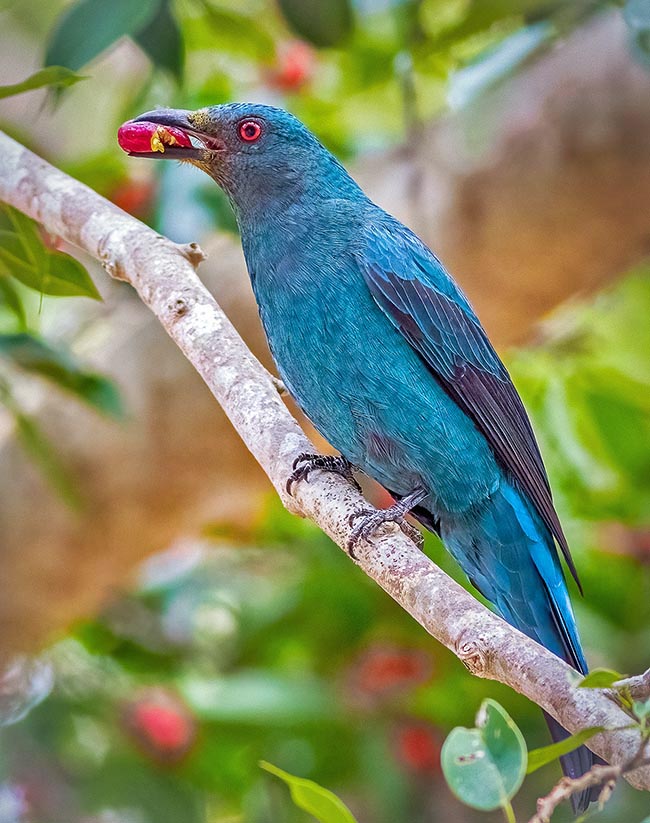
Female livery is different: more homogeneous, changing from malachite green to bluish green, at times even aquamarine with strong light intensities, whilst the wings and tail feathers are mainly greyish © Mike Rose
The poaching involving it as domestic and as singing competition animal forms another important form of threat for the species, probably to a lesser extent than the others.
Usually, the blue-backed Irena results in being a less popular species, and therefore difficult to be found, but its destiny might soon change because of its lively colours and its melodious singing that are increasing its demand.
At times it can conquer the enmities of the farmers, as nourishing of fruits and of coffee beans in the orchards and in the plantations, but this phenomenon doesn’t look too worrying.
The blue-backed Irena usually prefers to frequent the natural environments, where more easily abound tall trees from which it hardly likes to separate.
Ecology-Habitat
The blue-backed Irena is a typical passeriform of the forest vaults, or more precisely, of the “canopy”, where it stays for most of its time.
It tends to fly from one tree to another, looking for fruits with a predilection for those of the Ficus benjamina and of the Macaranga bancana.
At times it can cut the fruits also while flying, chopping the bigger ones with its strong and long bill.
The parents take care to find the insects necessary for feeding their progeny, as these require a significant protein intake for their development. The adults too may eat insects, as well as berries and nectar flowers.
The Irena puella performs in this way several ecological rôles of major importance for the forest ecosystems, assuming a position of regulator of the populations of insects and of dispenser of seeds and pollen.
It populates and frequents various types of botanical associations, including the mountain forests, the wooded wetlands and the moors of the island of Sunda. They are not migratory animals that, as already mentioned, they love to stay along the apexes of the forests, but can move significantly for searching the food they need, even venturing in the cultivated areas. The blue-backed Irena hardly loves to stay alone, forming small flocks or moving in couples.
Morphophysiology
Often, in the birds it happens to be able to appreciate morphological characteristics only on the males, but in this species both sexes present a look in their whole, showy, elegant and rare.
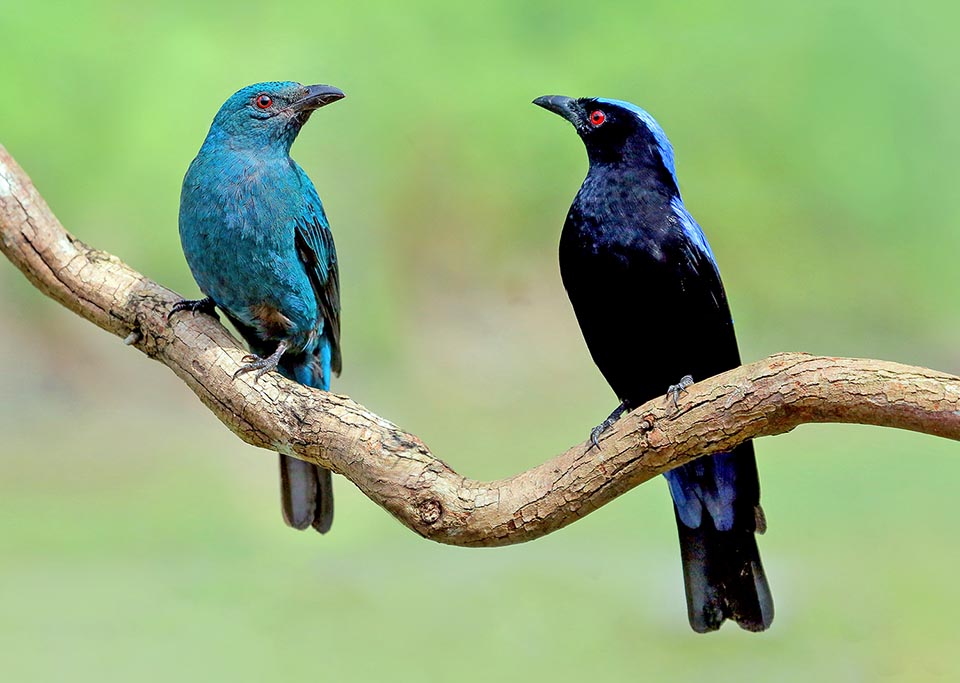
Irena puella is monogamous. Bonds between male and female are very strong and affectionate with mutual grooming and frequent calls © Duy My
The structure of the black-backed Irena is lusty, giving a strong flight and posture. It can reach 27 cm of length, with the females slightly smaller than the males. Moreover, the females are lighter, though not in a significant way, weighing from 52 to 71 g, whilst the males have a weight between 56 and 75 g.
Already from their eyes we can appreciate garish colours thanks to the characteristic crimson red iris, at times more orange in the female. Both sexes present bill and lower limbs greyish black, even if in the female this may result paler. These plumages are quite different, allowing an immediate distinction.
The plumage of the mail is black, on which is the famous bright azure colouration, from the proximity of the bill up to the tail. With closed wings, the azure plumage seems often interrupting between back and tail, giving the impression of being less extended than what really is, going even in the undertail. The tip of the tail is black, as well as a good part of the wings. We have already mentioned the fact that depending on the luminosity, the light blue colouration of the male may get dull varying its shades noticeably. from light blue to blue, creating at times particular optical effects.
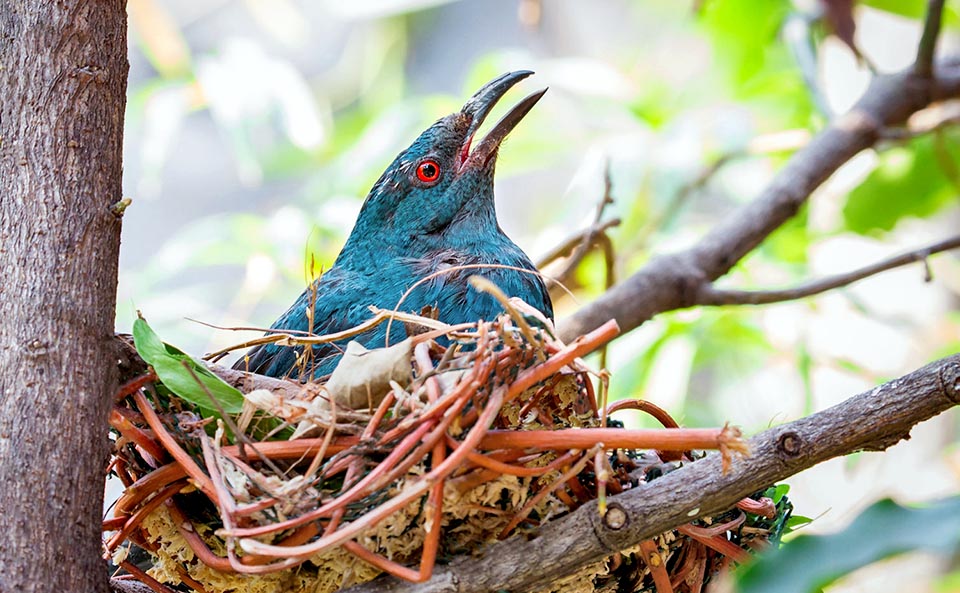
The not too deep nest, well hidden, contains 2-4 eggs. Hatching, entrusted to the female, lasts about two weeks © Kevin Wells
The female does not have garments able to flaunt similar complex effects, but the barbs of its plumage may however give life to intriguing metallic reflection, always depending on the light incidence. Its plumage is more homogeneous, from the malachite green to the bluish green, at times even aquamarine if interested by strong light intensities. The feathers of the wings and of the tail are usually of darker shades, tending to grey; depending on the individual, we can moreover identify more or less extended distributions of greyish shades all along the plumage, often predominant around the bill.
The young present a colour of the iris tending to brown and plumages very similar to those of the adult females, with the males usually slightly more bluish. In the males the typical final plumage takes form gradually, favouring in the young the formation of more or less evident spots. While growing, also the bright bluish liveries appear little by little; the young males can in this way exhibit a sort of plumage hybrid between the two sexes again for the benefit of their recognition.
Presently the blue-backed Irena has six subspecies, even if some scholars see between these some species standing alone: the I. p. andamanica of the Andaman and Nicobar islands and the aforementioned I. p. tweeddalei.
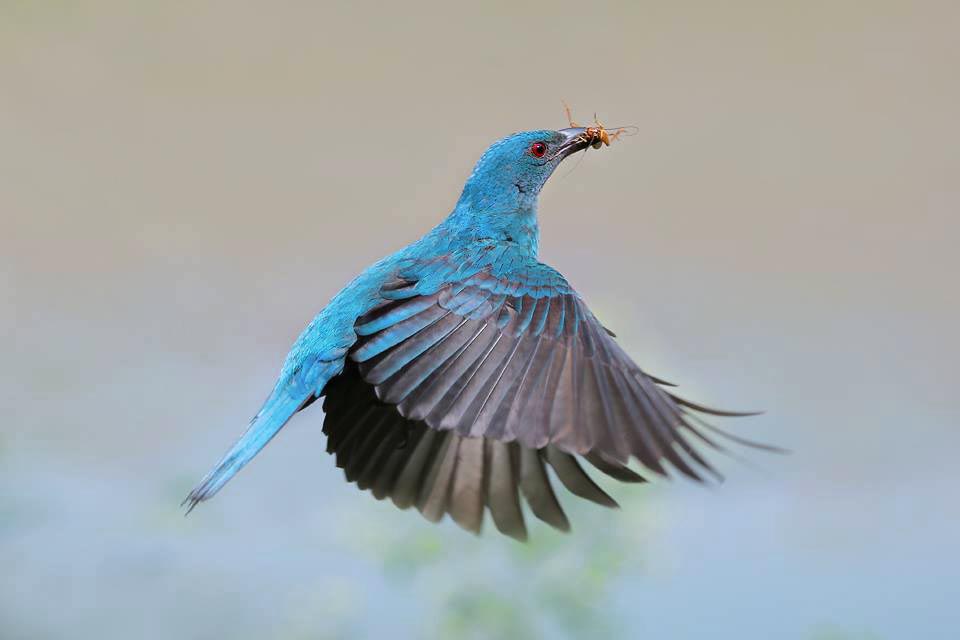
The newborns are fed with insects by both parents. 12 days after hatch they are already able to fly, at 40 days they are independent © Duy My
Despite the huge diffusion of this animal, are not present among the subspecies particularly significant differences; these are appreciable at the level of body dimensions, with the northern populations usually little bigger (true especially for the nominal subspecies, the I. p. puella, diffused in India, Nepal, southern China and Indochina), of the azure plumage of the males and of the form and length of the supracaudal coverts. The supracaudal coverts are often considered as the parametre of main distinction: in this case the southern subspecies have bigger dimensions, with longer coverts. We are talking about the I. p. malayensis, in the Malay Peninsula and Singapore, of the I. p. turcosa, and of the I. p. crinigera.
Ethology-Reproductive Biology
The life of a couple is an important component in these animals, monogamous par excellence. In captivity, it has been possible to ascertain the formation of very strong and affectionate bonds between the male and its female, with mutual grooming and calls. The observation of the individuals in their natural habitats is not that easy but also in this case stand out various instances of affinity inside the couple, such as the tendency to always move in unison, even if in presence of other individuals, and the tendency to isolate themselves during the reproductive period.
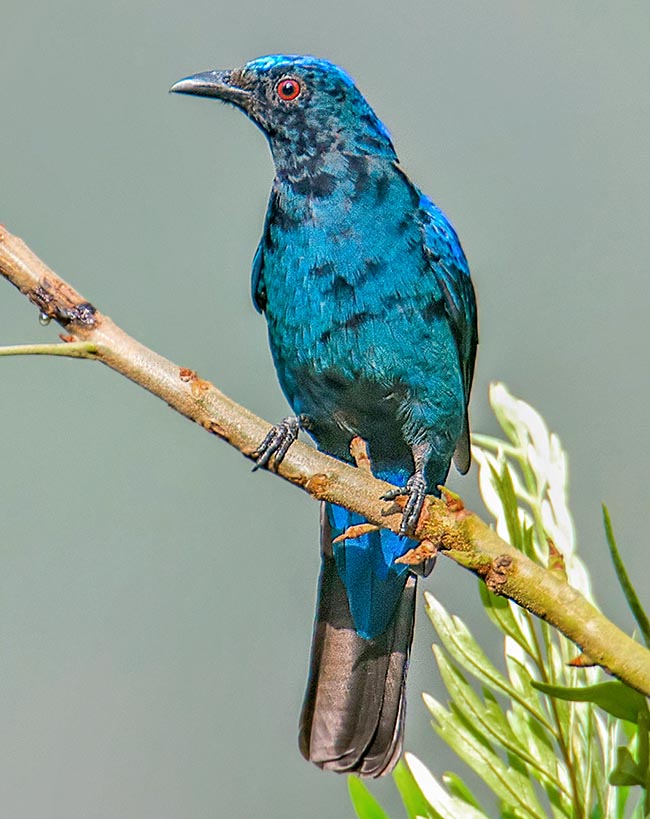
Subadult male of Irena puella. The young livery is very similar to the females one, less showy and surely more mimetic to the predators eyes. Later, in the males originate gradually some black dots © Bishan Monnappa
The reproductive season is distributed over a period of time depending on the specific geographical area; usually the most important phases stand between February and April.
The sexual maturation in both sexes comes already when one year old, sufficient to encourage the searches for the soul mate.
The courting of the male towards the female is based mainly on the emission of melodious songs and is frequently accompanied by rapid jerks of the head and of the tail.
The male can also crouch making body swings accompanied by neck stretching, tal vibrations and slight opening and vibration of the wings aimed to exalt the azure plumage to the eyes of the potential partner.
If the female suffers the male charm, it skips any pleasantries showing its own mutual interest by proceeding immediately with the construction of the nest.
During the courting have been observed also purposes between the two sexes and calls done by the female, as well as the development of a paler crimson red in the eyes of the male.
Materials of various kinds like twigs, grass, leaves and moss are processed by the female in order to camouflage the nest to the eyes of predators and to give it a not too deep cup shape. The faculty of the plumage of both sexes to become dull and to darken into the vegetation forms a further and additional factor of camouflage to protect the nest, built on the trees or on high bushes.
The female lays two to four eggs of greenish grey colour with brown dots and having a length up to 3 cm.
The hatching is done by the female and lasts about two weeks, whilst the care of the progeny is the duty of both partners.
Upon the birth the newborns are blind and are unable to nourish by themselves, becoming completely independent around the forty days of life. In nature, the average life varies from eight to twelve years, whilst when in captivity it may reach even twenty.
Synonyms
Coracias puella (J. Latham, 1790).
→ To appreciate the biodiversity within PASSERIFORMES please click here.
